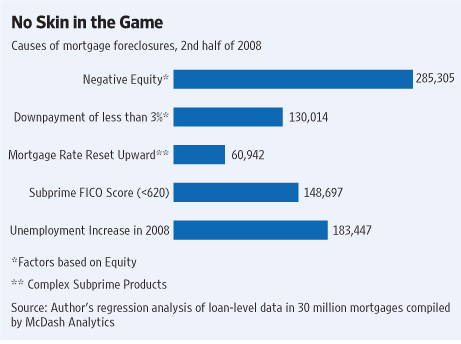 An article published in the Wall St. Journal this week by Stan Liebowitz posits a purportedly new take on the causes of the mortgage meltdown. Liebowitz’s analysis of recent data on millions of individual loans published by McDash Analytics, a component of Lender Processing Services Inc., compares the importance of several variables related to mortgage foreclosures. His conclusion? That the most important factor is whether the borrower has or ever had positive equity in the home (see graphic at right).
An article published in the Wall St. Journal this week by Stan Liebowitz posits a purportedly new take on the causes of the mortgage meltdown. Liebowitz’s analysis of recent data on millions of individual loans published by McDash Analytics, a component of Lender Processing Services Inc., compares the importance of several variables related to mortgage foreclosures. His conclusion? That the most important factor is whether the borrower has or ever had positive equity in the home (see graphic at right).
A borrower’s equity in a home is often expressed in terms of
loan-to-value (“LTV”) ratio, or the amount of the first lien the borrower took out on the home compared to the appraised value of the home. So, if a borrower took out a $450,000 loan on a home valued at $500,000 (and made a $50,000 down payment), the LTV ratio on the mortgage would be 90%. An even better statistic is the combined loan-to-value (CLTV) ratio, which measures the amount of all loans taken out on the home compared to the value of the home, and thus includes second liens and HELOCs in the calculation. During the late years of the housing bubble, it became increasingly popular for borrowers to take out one loan on the first 80% of the value of the home, and a second loan for the rest, which meant that borrowers had no skin in the game, and often led to negative equity situations when housing prices crashed.
LTV and CLTV ratios were always one of the most important factors for gauging the riskiness of a loan. Thus, Liebowitz’s conclusion is not surprising. Borrowers with little or no equity in their home are much more likely to walk away from the loan when times get tough, whereas those who have put a significant amount of their own money into their home are more likely to try to work out a payment plan or put their home on the market. But from this rather unremarkable finding, Liebowitz attempts to proffer a much broader revelation and debunk the “common narrative” that subprime lending and stated income loans were significant causes of the foreclosure crisis.
While Liebowitz may be correct that the impact of subprime lending and stated income loans on foreclosures was more limited than the “common narrative” suggests, the truth is that this type of lending was symptomatic of the drastic loosening in underwriting standards that preceded the housing collapse of 2007. And, as Liebowitz recognizes, this loosening was enabled and fueled by a government- and Wall St.-backed campaign to artificially increase homeownership levels beyond where they should have been. If borrowers were really able to afford the homes that they were purchasing, they would have made sizable down payments so as to earn better interest rates over the life of their loans.
Instead, because the government was providing tax and other incentives to expand lending, Wall St. was making considerable profits from securitizing and selling these additional loans, and borrowers were happy to delude themselves into thinking that if they qualified for a loan, they could afford to own the home, this country experienced an explosion in irresponsible lending and borrowing that led us inevitably to the credit crunch we’re experiencing today. Subprime was a symptom of this unsustainable growth in lending and a symbol of the excesses this culture engendered. Ask yourself if you were a lender under ordinary lending conditions, would you give a borrower with a blemished credit record a loan for the full amount of the house, without requiring any down payment or an income tax return?
This is where Liebowitz and I, and most other experts on this subject, can most readily agree. Stronger underwriting standards are indeed necessary to return lending to the rational risk-assessment process it was intended to be.
The tougher issue is what to do about the current pool of “toxic assets,” backed by distressed loans, that are freezing up our credit markets. This solution is more nuanced and complex, and involves a loan-by-loan assessment. If the borrower cannot afford and could never have afforded the home, there must be a foreclosure. If the borrower was misled into the loan, the servicer should help effect a loan modification, the cost of which should be born by the lender or broker who acted in a predatory or fraudulent manner. And for everyone else who borrowed reasonably but who, due to the current financial crisis or a change of circumstances, cannot now afford to make their payments, we must decide as a society what makes the most sense.
Thank you to Michael Ginsborg at the Howard Rice Library for passing along Liebowitz’s thought-provoking article – IMG.
 Servicers of home loans have thus far enjoyed preferential treatment by regulators in the shakeout from the recent financial crisis, but that may all be changing.
Servicers of home loans have thus far enjoyed preferential treatment by regulators in the shakeout from the recent financial crisis, but that may all be changing.
ZeroHedge
WSJ.com: Law Blog - WSJ.com
The Volokh Conspiracy
The D&O Diary
The Big Picture
The Becker-Posner Blog
The Baseline Scenario
On the Case
Naked Capitalism
Fire Dog Lake
Credit Slips
Calculated Risk





